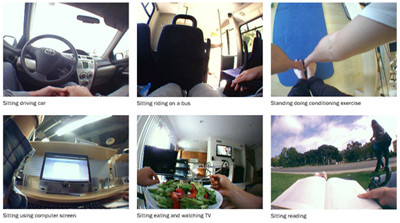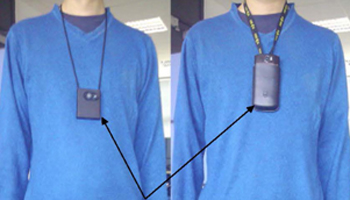Health Research and Conference Underscore Value of Wearable Life-Logging Devices
By calit2
UC San Diego to Host International SenseCam Symposium Nov. 18-19
San Diego, Feb. 8, 2013 -- Researchers at the University of California, San Diego are among the co-authors of articles in a special theme issue of the American Journal of Preventive Medicine (AJPM) about the use of wearable cameras in understanding lifestyle behaviors and health.
|
A paper on “Using the SenseCam to Improve Classifications of Sedentary Behavior in Free-Living Settings” shows, for example, the advantages of wearable cameras over accelerometers in providing both type and context information about sedentary behavior. UC San Diego School of Medicine assistant professor of family and preventive medicine Jacqueline Kerr and colleagues found that while TV viewing, other screen use, and administrative activities were correctly classified by accelerometers, standing postures are often misclassifıed as sedentary behavior.
“There was a nearly 30-minute-per-day difference in sedentary behavior estimates based on the accelerometer versus the SenseCam,” said Kerr, who is also a researcher in the Center for Wireless and Population Health Systems (CWPHS), part of the California Institute for Telecommunications and Information Technology (Calit2). “That is a major discrepancy and reaffirms our belief that health researchers should employ both technologies in future studies of sedentary behavior and inactivity.”
Co-authors with Kerr on the paper included Simon Marshall, Suneeta Godbole, Jacqueline Chen and Amanda Legge – all from UC San Diego – as well as researchers from the University of Oxford (UK), Auckland University of Technology (New Zealand), and University of Melbourne (Australia).
|
The two-day conference will bring together international experts in computational science, behavior science, health sciences, and related fields. Their goal: to explore the ethics, analysis and applications of life-logging images to health and related behaviors.
“The conference will also explore guidelines to allow comparable methods across studies which will advance the science,” said Kerr, a member of the SenseCam 2013 organizing committee. “In particular, we hope to identify new applications and opportunities to use images to change behaviors – demonstrating that a picture really is worth a thousand words.”
The special March 2013 theme issue of the American Journal of Preventive Medicine (Vol. 44, Issue 3), published by Elsevier, included Kerr’s report as well as five other articles devoted to the use of wearable cameras in health-related research.
|
Aiden R. Doherty. from the Department of Public Health at the University of Oxford (UK), was the lead author of the overview report on “Wearable Cameras in Health: The State of the Art and Future Possibilities.” “Wearable cameras and their associated software analysis tools have developed to the point that they now appear well suited to measure sedentary behavior, active travel, and nutrition-related behaviors,” said Doherty. “Individuals may recall events more accurately after reviewing images from their wearable cameras, and in addition, aspects of their immediate cognitive functioning may also improve.” ”
That result is borne out in a separate article on the “Benefits of SenseCam Review on Neuropsychological Test Performance.” In the article, Ana R. Silva and colleagues highlight how wearable cameras can act as a cognitive stimulant in the short term. Compared to re-reading diary entries, the SenseCam wearable camera was found to improve autobiographic memory by prompting events reflected in the images, underlining the possibility of using SenseCam in memory rehabilitation. While future research is still needed, the researchers propose that wearable cameras have the potential to reduce the resources required in treating neurodegenerative diseases, such as Alzheimer’s.
Another study, “The Smartphone as a Platform for Wearable Cameras in Health Research,” recognizes obstacles in the widespread adoption of Microsoft’s SenseCam wearable camera, and presents smartphones as a viable, and in some cases enhanced, alternative.
Finally, a study by researchers in Ireland analyzed how wearable cameras were employed to improve the recording of dietary intake among jockeys, Gaelic footballers, and physically active college students. They reported that images from the SenseCam provided additional information regarding dietary intake patterns, such as portion size, forgotten foods, leftovers, and brand names. As a result, adding wearable cameras to dietary analysis should help athletes who closely monitor their caloric intake, and may also help dieticians and health providers assess and treat those in need of dietary management.
Media Contacts
Doug Ramsey, 858-822-5825, dramsey@ucsd.edu
Related Links
American Journal of Preventive Medicine
Center for Wireless and Population Health Systems
Elsevier: Wearable Cameras Provide New Insight into Lifestyle Behaviors and Health
SenseCam Study Helps Show Humans, Machines What ‘Healthy’ Looks Like Mynet sohbet Badoo




